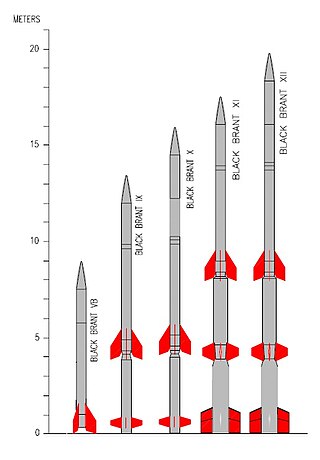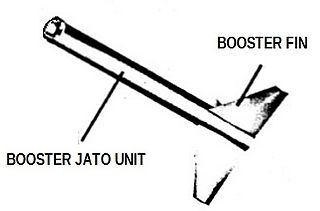
The Space Shuttle is a retired, partially reusable low Earth orbital spacecraft system operated from 1981 to 2011 by the U.S. National Aeronautics and Space Administration (NASA) as part of the Space Shuttle program. Its official program name was Space Transportation System (STS), taken from the 1969 plan led by U.S. Vice President Spiro Agnew for a system of reusable spacecraft where it was the only item funded for development, as nuclear shuttle in the plan was cancelled.

Rotary Rocket Company was a rocketry company that developed the Roton concept in the late 1990s as a fully reusable single-stage-to-orbit (SSTO) crewed spacecraft. The design was initially conceived by Bevin McKinney, who shared it with Gary Hudson. In 1996, Rotary Rocket Company was formed to commercialize the concept. The Roton was intended to reduce costs of launching payloads into low Earth orbit by a factor of ten.

The Black Brant is a family of Canadian-designed sounding rockets originally built by Bristol Aerospace, since absorbed by Magellan Aerospace in Winnipeg, Manitoba. Over 800 Black Brants of various versions have been launched since they were first produced in 1961, and the type remains one of the most popular sounding rockets. They have been repeatedly used by the Canadian Space Agency and NASA.

Little Joe 1 (LJ-1) was a failed launch of a Little Joe by NASA, a solid fuel rocket that was designed for a Max Q abort and launch escape system test for the Mercury capsule. The objective was to determine how well the escape rocket would function under the most severe dynamic loading conditions anticipated during a Mercury-Atlas launching.

Little Joe was a solid-fueled booster rocket used by NASA for eight launches from 1959 to 1961 from Wallops Island, Virginia to test the launch escape system and heat shield for Project Mercury capsules, as well as the name given to the test program using the booster. The first rocket designed solely for crewed spacecraft qualifications, Little Joe was also one of the pioneer operational launch vehicles using the rocket cluster principle.

Atlas II was a member of the Atlas family of launch vehicles, which evolved from the successful Atlas missile program of the 1950s. The Atlas II was a direct evolution of the Atlas I, featuring longer first-stage tanks, higher-performing engines, and the option for strap-on solid rocket boosters. It was designed to launch payloads into low Earth orbit, geosynchronous transfer orbit or geosynchronous orbit. Sixty-three launches of the Atlas II, IIA and IIAS models were carried out between 1991 and 2004; all sixty-three launches were successes, making the Atlas II a highly reliable space launch system. The Atlas line was continued by the Atlas III, used between 2000 and 2005, and the Atlas V, which is still in use as of 2024.

The Scout family of rockets were American launch vehicles designed to place small satellites into orbit around the Earth. The Scout multistage rocket was the first orbital launch vehicle to be entirely composed of solid fuel stages. It was also the only vehicle of that type until the successful launch of the Japanese Lambda 4S in 1970.

Bérénice was the designation of a four-stage French atmospheric reentry test rocket, developed by O.N.E.R.A. .
The Sea Dragon was a 1962 conceptualized design study for a two-stage sea-launched orbital super heavy-lift launch vehicle. The project was led by Robert Truax while working at Aerojet, one of a number of designs he created that were to be launched by floating the rocket in the ocean. Although there was some interest at both NASA and Todd Shipyards, the project was not implemented.

Romanian Cosmonautics and Aeronautics Association, also known as ARCAspace, is an aerospace company based in Râmnicu Vâlcea, Romania. It builds rockets, high-altitude balloons, and unmanned aerial vehicles. It was founded in 1999 as a non-governmental organization in Romania by the Romanian engineer and entrepreneur Dumitru Popescu and other rocket and aeronautics enthusiasts. Since then, ARCA has launched two stratospheric rockets and four large-scale stratospheric balloons including a cluster balloon. It was awarded two governmental contracts with the Romanian government and one contract with the European Space Agency. ARCASpace is currently developing several rocket systems, both orbital and suborbital, under the EcoRocket program. These vehicles include the CER rocket systems, the EcoRocket Demonstrator, Nano, 5 & Heavy, and the A1 strategic anti-ballistic interceptor. ARCA has yet to launch a vehicle above the Karman line, or sent a payload to orbit, with the majority of their projects having been abandoned due to various reasons, often including financial or regulatory constraints.
Saturn V-A was a proposed American orbital launch vehicle. It was studied by Marshall Space Flight Center in 1968. the Saturn V-A was identical to the Saturn INT-20, except it consisted of an ordinary S-IC first stage and S-IVB second stage. For deep-space missions, a Centaur third stage could also have been used.

VSB-30 - "Veículo de Sondagem Booster – 30" or "Foguete Suborbital VSB-30" is the designation of a Brazilian sounding rocket, which replaced the Skylark rocket at Esrange.

Antares, known during early development as Taurus II, is an expendable launch system developed by Orbital Sciences Corporation and the Pivdenne Design Bureau to launch the Cygnus spacecraft to the International Space Station as part of NASA's COTS and CRS programs. Able to launch payloads heavier than 8,000 kg (18,000 lb) into low Earth orbit, Antares is the largest rocket operated by Northrop Grumman. Antares launches from the Mid-Atlantic Regional Spaceport and made its inaugural flight on April 21, 2013. Antares 100 was retired in 2014 and series 200 was retired in 2023 due to component unavailability. As of January 2024 Antares 300 is under development.

Vanguard TV-3BU, also called Vanguard Test Vehicle-Three Backup, was the second flight of the American Vanguard rocket. An unsuccessful attempt to place an unnamed satellite, Vanguard 1B, into orbit, the rocket was launched on 5 February 1958. It was launched from LC-18A at the Cape Canaveral Air Force Station. Fifty-seven seconds after launch, control of the vehicle was lost, and it failed to achieve orbit. At 57 seconds, the booster suddenly pitched down. The skinny second stage broke in half from aerodynamic stress, causing the Vanguard to tumble end-over-end before a range safety officer sent the destruct command. The cause of the failure was attributed to a spurious guidance signal that caused the first stage to perform unintended pitch maneuvers. Vanguard TV-3BU only reached an altitude of 6.1 km (3.8 mi), the goal was 3,840 km (2,390 mi).

Antares A-ONE mission was the maiden flight of Orbital Sciences Corporation' Antares launch vehicle including the ascent to space and accurate delivery of a simulated payload, the Cygnus Mass Simulator (CMS), which was launched 21 April 2013. It was launched from Pad 0A at the Mid-Atlantic Regional Spaceport (MARS), Wallops Flight Facility, Virginia. The simulated payload simulates the mass of the Cygnus cargo spacecraft. This dummy payload was sent into an orbit of 223 km × 237 km with an orbital inclination of 51.63°, the same launch profile it will use for Orbital's Cygnus cargo supply missions to the International Space Station (ISS) for NASA.

The Nike stage or Nike booster, a solid fuel rocket motor, was created by Hercules Aerospace for the Nike Ajax (M5) Nike Hercules (M5E1). It was developed for use as the first stage of the Nike Ajax and Nike Hercules missiles as part of Project Nike.

Electron is a two-stage, partially reusable orbital launch vehicle developed by Rocket Lab, an American aerospace company with a wholly owned New Zealand subsidiary. Electron services the commercial small satellite launch market. It's the third most launched small-lift launch vehicle in history. Its Rutherford engines are the first electric-pump-fed engine to power an orbital-class rocket. Electron is often flown with a kickstage or Rocket Lab's Photon spacecraft. Although the rocket was designed to be expendable, Rocket Lab has recovered the first stage twice and is working towards the capability of reusing the booster. The Flight 26 (F26) booster has featured the first helicopter catch recovery attempt. Rocket Lab has, however, abandoned the idea of catching Electron.

Vanguard SLV-5, also called Vanguard Satellite Launch Vehicle-Five hoped to be the third successful flight of the American Vanguard rocket following the successful Vanguard 2 satellite on rocket Vanguard SLV-4.

Vanguard SLV-6, also called Vanguard Satellite Launch Vehicle-Six, hoped to be the third successful flight of the American Vanguard rocket following the successful Vanguard 2 satellite on rocket Vanguard SLV-4. Vanguard Satellite Launch Vehicle-6 (SLV-6) was designed to carry a small spherical satellite into Earth orbit to study solar heating of Earth and the heat balance. A faulty second stage pressure valve caused a mission failure.
Nike Yardbird was an American sounding rocket with two stages, based upon the Nike Hercules M5E1 booster and a Thiokol TE-289 Yardbird upper stage. Yardbird was an improved Thiokol XM-19 motor. The Nike Yardbird was launched 2 times from Wallops Island on Sphere Test aeronomy missions both of which were classified as failures. Information available does not state the reason for the mission failures but Astronautix lists the apogee of both missions as 10 km (6 mi) which is well below the goal of 120 km (70 mi).
















